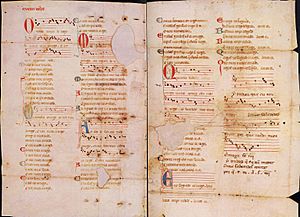Martin Codax facts for kids
Martin Codax was a famous musician and poet from Galicia, a region in what is now Spain. He lived a long time ago, around the middle of the 1200s. He was a joglar, which means he was a performer who wrote and sang his own songs. This was different from a trobador, who was usually a noble person.
Martin Codax is special because he only used an old-fashioned song structure. He also used a unique rhyming style. He was very good at a technique called leixa-pren. This is where lines are repeated with small changes, making the songs flow nicely. We don't have many written records about his life. Most of what we know about him comes from studying his poems.
Martin Codax's Songs in the Vindel Parchment
Martin Codax wrote seven songs called cantigas d'amigo. These songs are found in old Galician-Portuguese songbooks. They also appear in a special document called the Pergaminho Vindel (Vindel parchment). In all these old writings, Martin Codax is listed as the author of these seven songs. The songs are always in the same order. This is important because it suggests that poets might have arranged their songs in a specific way for performances.
The Vindel parchment was found by a bookseller named Pedro Vindel in 1913. It was being used as a cover for an old book!
Here are the names of Martin Codax's songs from the parchment (they were originally untitled, so they are known by their first line):
- Ondas do mar de Vigo (Waves of the sea of Vigo)
- Mandad'ey comigo (You sent with me)
- Mia irmana fremosa treydes comigo (My beautiful sister, come with me)
- Ay Deus, se sab'ora meu amigo (Oh God, if my friend knew now)
- Quantas sabedes amar amigo (All of you who know how to love a friend)
- Eno sagrad' en Vigo (In the sacred place in Vigo)
- Ay ondas que eu vin veer (Oh waves that I came to see)
What makes the Pergaminho Vindel even more amazing is that it has musical notes for most of these songs! This means we know how six of his seven songs were meant to sound. These are the only cantigas d'amigo for which we have the music. Another old document, the Pergaminho Sharrer, has music for seven cantigas d'amor by Denis of Portugal.
One of Martin Codax's Songs
Here is the third of his songs, translated into English:
|
Mia irmana fremosa, treides comigo |
Lovely sister, come with me |
See Also
 In Spanish: Martín Códax para niños
In Spanish: Martín Códax para niños
- Cantiga de amigo
- Galician-Portuguese
- Galician-Portuguese lyric
- Pergaminho Sharrer


